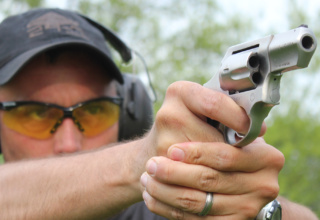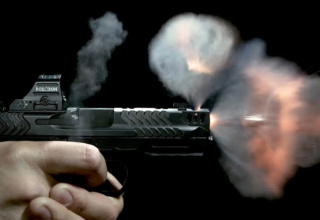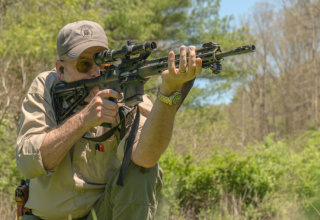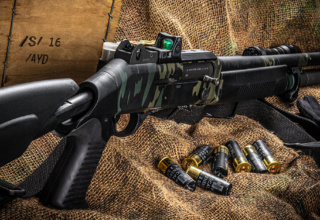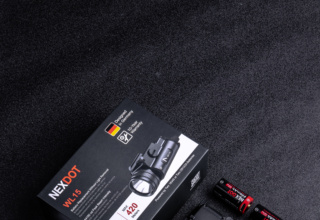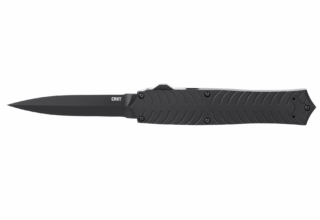Understanding the importance of single-handed shooting
by Paul G Markel
“Wow, I did better than I thought I would.”
So said a student who just conducted a shooting drill using his left, or off, hand.
This was not the first time I had encountered such a response from a shooter who was required by the course of fire to shoot with their off hand. As a matter of fact, such an occurrence happened in just about every class.
My response to this epiphany was to ask them why they believed they performed better than they had anticipated. I’m paraphrasing, but the reply from most every student was something to the effect that they felt “nervous” or “anxious” because they never used their off hand, so they focused “really hard” on their front sight focus and their trigger press. To that I would respond, “Good. Do that all the time, regardless of which hand you are using.
Your Left Hand Makes Your Right Hand Better
Most studies have found that at least 90 percent of the American population is right-handed. Of the remaining 10 percent, there are the left-handed and the truly ambidextrous. The ambi crowd is rounded up to 1 percent of the population.
Regardless of your “handedness,” your primary or preferred hand, for our purposes in teaching martial tactics, is the “dominant hand” and the other one becomes the de facto “support hand.”
One of the mantras that forward-thinking small arms and tactics instructors have been pushing is that the more you practice with your support, or off hand, the better skilled your strong or dominant hand will become. Experienced instructors and coaches know that the previous assertion is true based upon what we witness with our own eyes on the range. But what about “the science?” Are there studies to support what we know?
Well, yes there are. We found one called Mastering Coordination: How Practicing with Your Non-Dominant Hand Transforms Your Health. That article considers the brain-body connection, the importance of physical coordination, and abilities. Here is a quote from the article:
“When you develop better coordination, you’re essentially improving the brain’s ability to process and react to various physical and sensory inputs. Coordination helps optimize the brain-body connection, making everyday tasks feel more fluid and effortless.”
Considering our goal — to be able to use a handgun in the gravest extreme to save our lives and the lives of those we love — you can see how “improving the brain’s ability to process and react to various physical and sensory inputs” might be of benefit to us. Heck, that is what self-defense is about: processing or reacting to physical and sensory inputs.
We also know that doing hard or difficult things, things that we might not otherwise want to do, produces growth and improves health in the brain, specifically, the anterior mid-cingulate cortex (aMCC). The aMCC regulates your level of tenacity, your will, and will to live. Most people will not shoot one-handed or with their off-hand-only because their “groups aren’t tight” or they think that they won’t look cool in front of others.
Returning to the opening paragraph of this article, the vast majority of students who come through our class have never fired their pistols with their non-dominant hands. There is a psychological barrier, a fear or performance anxiety, yet we require them to do it. And, in the aftermath, 99% are surprised that they were able to succeed. No, it is not easy. That’s why they must concentrate and focus intently on doing everything right.
Tactical Considerations
We have discussed the psychological and physiological reasons why you should practice shooting with your support hand only as well as your dominant hand only, but what about tactical considerations?
Gunfights are hyper-violent, largely unpredictable, and stressful events. If a monster, or monsters, has (have) made the decision to threaten you with deadly force, you might “hope for the best” but you sure better “prepare for the worst.”
One of those worst-case scenarios is an injury to either your dominant or support hand, arm, or shoulder. If the threat is still active and you are down to only one arm, you cannot call time out and beg for mercy.
During the infamous FBI Miami Shootout, 8 of the 10 participants received an injury to either their dominant or support arm. Ed Mireles, the hero of the day who ended the fight, took a .223 round to his left forearm in the first 90 seconds of the fight. He fired 5 rounds from his Remington 870 shotgun and 6 rounds from his S&W revolver using only his right hand. Eighty percent of those in the Miami gunfight had arm injuries! Ed has a tough time getting in and out of chairs due to his huevos grande condition.
During the Norco Bank Robbery, six of the eight police officers shot and wounded during that gun battle were struck in the hand or arm or elbow or shoulder. That is a 75% injury rate to one arm or the other. Also, during the North Hollywood Bank Robbery, four of the officers hit with gunfire were struck in the arm or shoulder. Both bank robbers were shot in at least one of their hands or arms. Emil Mătăsăreanu, one of the robbers, was shot 29 times before finally succumbing to his injuries and dying.
As you can see, being struck in the hand/arm/shoulder during a gunfight is not a rarity but would seem to be rather commonplace. Understanding that we need to keep fighting and not just lie there, training and practicing using your handgun with only one hand seems to be a prudent and important skill to develop.
Your Vision
During my tenure as a 4H Shooting Sports instructor, I learned that the best way to help young, new shooters to succeed was to first determine their eye dominance. Like handedness, humans have a natural tendency to be either right or left eye dominant. Cross-dominance does exist, but it is rare, like a truly ambidextrous person.
While I can instruct you to use your left hand to pick up a pencil, I cannot look at you and say, “Okay, be left eye dominant now.” Eye dominance is subconscious. What we in the 4H Shooting Sports program discovered was that new shooters who were taught to shoot from the dominant eye side, regardless of handedness, succeeded and improved far faster than trying to cover an eye or close an eye. My daughter is truly left-handed, but she is right eye dominant, and she excelled at archery and shotgun sports using her right hand.
Naturally, if a person is right eye and right hand dominant, but has a pistol in their left hand, it is a simple matter of canting the gun slightly, about 45 degrees, to bring the sights in line with the dominant right eye. Yes, it must be practiced, but it is not that difficult after you spend some time doing so.
Training and Practice
By this time, you should realize the value and importance of shooting with your dominant hand only as well as your support hand only. If you participate in a training class that neglects these, in my ever so humble opinion, you are being shortchanged.

Also, even if you are required in training to do the previous, you still need to practice that when you are on your own. Many years ago, we developed the One Box Workout, a skill maintenance program. In the OBW, single-handed shooting consists of 40 percent of the practice routine.
Are you willing to park your ego and do what needs to be done? That, my friends, is a choice that you must make. If you have already been doing so, you can find comfort in knowing that you have been correct all this time.






